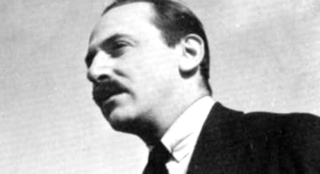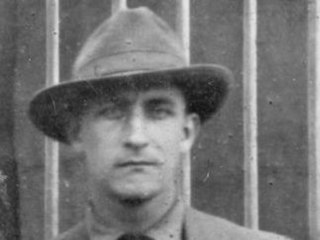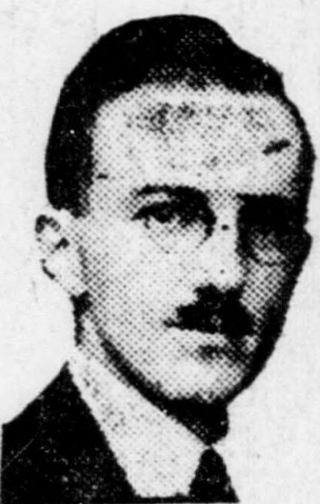Related Research Articles

William Carlos Williams was an American poet, writer, and physician closely associated with modernism and imagism.

Nathanael West was an American writer and screenwriter. He is remembered for two darkly satirical novels: Miss Lonelyhearts (1933) and The Day of the Locust (1939), set respectively in the newspaper and Hollywood film industries.
The Objectivist poets were a loose-knit group of second-generation Modernists who emerged in the 1930s. They were mainly American and were influenced by, among others, Ezra Pound and William Carlos Williams. The basic tenets of objectivist poetics as defined by Louis Zukofsky were to treat the poem as an object, and to emphasize sincerity, intelligence, and the poet's ability to look clearly at the world. While the name of the group is similar to Ayn Rand's school of philosophy, the two movements are not affiliated.

transition was an experimental literary journal that featured surrealist, expressionist, and Dada art and artists. It was founded in 1927 by Maria McDonald and her husband Eugene Jolas and published in Paris. They were later assisted by editors Elliot Paul, Robert Sage, and James Johnson Sweeney.

Robert Menzies McAlmon was an American writer, poet, and publisher. In the 1920s, he founded in Paris the publishing house, Contact Editions, where he published writers such as Ernest Hemingway, Gertrude Stein, James Joyce and Ezra Pound.

William Augustus Bird (1888–1963) was an American journalist, now remembered for his Three Mountains Press, a small press he ran while in Paris in the 1920s for the Consolidated Press Association. Taken over by Nancy Cunard in 1928, it became the Hours Press, and continued its association with many of the most important modernists; Ezra Pound had a position as editor for Three Mountains from 1923.
The Dial was an American magazine published intermittently from 1840 to 1929. In its first form, from 1840 to 1844, it served as the chief publication of the Transcendentalists. From the 1880s to 1919 it was revived as a political review and literary criticism magazine. From 1920 to 1929 it was an influential outlet for modernist literature in English.
Robert Myron Coates was an American novelist, short story writer and art critic. He published five novels; one classic historical work, The Outlaw Years (1930) which deals with the history of the land pirates of the Natchez Trace; a book of memoirs, The View from Here (1960), and two travel books, Beyond the Alps (1962) and South of Rome (1965). During his unusually varied career, Coates explored many different genres and styles of writing and produced three highly remarkable experimental novels, The Eater of Darkness (1926), Yesterday’s Burdens (1933) and The Bitter Season (1946). Highly original and experimental, these novels draw upon expressionism, Dadaism and surrealism. His last two novels—Wisteria Cottage (1948) and The Farther Shore (1955)—are examples of crime fiction. Simultaneously to working as a novelist, Coates maintained a life-long career at the New Yorker, whose staff he joined in 1927. The magazine printed more than a hundred of his short stories many of which were collected in three anthologies; All the Year Round (1943), The Hour after Westerly (1957) and The Man Just ahead of You (1964). Also, from 1937 to 1967, Coates was the New Yorker’s art critic and coined the term “abstract expressionism” in 1946 in reference to the works of Hans Hofmann, Arshile Gorky, Jackson Pollock and Willem de Kooning and others. He was elected to the National Institute of Arts and Letters in 1958. Coates was married to sculptor Elsa Kirpal from 1927 to 1946. Their first and only child, Anthony Robertson Coates, was born on March 4, 1934. In 1946, they divorced and Coates married short story writer Astrid Meighan-Peters. He died of cancer of the throat in New York City on February 8, 1973.
John Theodore Herrmann was a writer in the 1920s and 1930s and is alleged to have introduced Whittaker Chambers to Alger Hiss.
The Little Review, was an American literary magazine founded by Margaret Anderson in Chicago's historic Fine Arts Building, published literary and art work from 1914 to May 1929. With the help of Jane Heap and Ezra Pound, Anderson created a magazine that featured a wide variety of transatlantic modernists and cultivated many early examples of experimental writing and art. Many contributors were American, British, Irish, and French. In addition to publishing a variety of international literature, The Little Review printed early examples of surrealist artwork and Dadaism. The magazine's most well known work was the serialization of James Joyce's Ulysses.

Alfred Francis Kreymborg was an American poet, novelist, playwright, literary editor and anthologist.

Spring and All is a volume of poems by William Carlos Williams, first published in 1923 by Robert McAlmon's Contact Publishing Co.
Bomb is an American arts magazine edited by artists and writers, published quarterly in print and daily online. It is composed primarily of interviews between creative people working in a variety of disciplines—visual art, literature, film, music, theater, architecture, and dance. In addition to interviews, Bomb publishes reviews of literature, film, and music, as well as new poetry and fiction. Bomb is published by New Art Publications, Inc., a 501(c)(3) non-profit organization.
Chicago Review is a literary magazine founded in 1946 and published quarterly in the Humanities Division at the University of Chicago. The magazine features contemporary poetry, fiction, and criticism, often publishing works in translation and special features in double issues.
Nicolas Calas was the pseudonym of Nikos Kalamaris, a Greek-American poet and art critic. While living in Greece, he also used the pseudonyms Nikitas Randos and M. Spieros.

Contempo, A Review of Books and Personalities, was a "literary and social commentary" published by Milton A. Abernethy and Anthony Buttitta at Chapel Hill, North Carolina from 1931 to 1934. Though less well-known than some of its contemporaries, Contempo fits into the tradition of the "Little Magazine," a group of elite literary magazines pervasive in the first decades of the twentieth century.
Stanley Rose was an American bookseller, literary agent, and raconteur, whose eponymous Hollywood bookshop, located adjacent to the famous Musso & Frank Grill restaurant, was a gathering place for writers working or living in and around Hollywood. Rose’s most notable literary associates were William Saroyan, to whom he was variously a friend, a drinking and hunting companion, and a literary representative; and Nathanael West, whose 1939 novel The Day of the Locust owed much of its “local color” to its author’s acquaintance with Rose.
Analisa Leppanen is an American writer, art historian and curator living in Saint Joseph, Michigan. As a scholar, she works on the art and visual culture of the nineteenth and twentieth centuries, with a focus on the historical avant-garde, in particular Dada and Surrealism. She has written on Diego Velázquez, Francisco Goya, Hugo Ball, Antonin Artaud, Lee Miller, Man Ray, Marcel Duchamp and others. She has published and lectured widely on the work of American artist Joseph Cornell.

Emanuel Carnevali was an Italian-American writer. His body of work includes poetry, literary criticism, autobiography, and other prose writings.

The Passion of Sacco and Vanzetti is a 1932 painting series by Ben Shahn consisting of 32 gouache paintings of Sacco and Vanzetti.
References
- 1 2 Chielens, Edward E., ed. "Contact". American Literary Magazines: The Twentieth Century. Westport: Greenwood, 1992. 74.
- ↑ Casella, Donna. "William Carlos Williams's Contact Magazine: A Rebellion against the Arty Art Worshipers". Ball State University Forum 28.3 (1987): 60-75.
- ↑ Dickran Tashjian (1978). William Carlos Williams and the American Scene, 1920-1940: Whitney Museum of American Art ... December 12, 1978-February 4, 1979. University of California Press. p. 24. ISBN 978-0-520-03854-7 . Retrieved 21 February 2016.